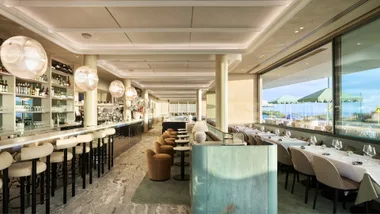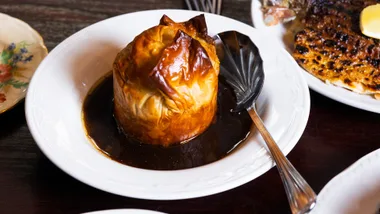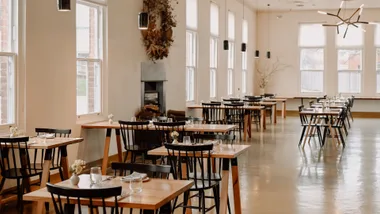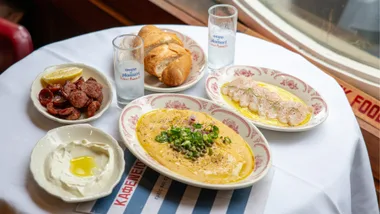Hako
310 Flinders La, Melbourne, Vic, (03) 9620 1881.
Lunch Mon-Fri, dinner Mon-Sat. Licensed.
Prices Entrées $3.80-$17.80, mains $17.80-$35.80.
Noise Humming sweetly.
Wheelchair access Not really.
Plus A great new environment for Japanese food in Melbourne.
Minus Too hard to get into and the wine list could use some work.
For the food and wine anthropologists among us, Melbourne’s lanes bring with them their own sense of exploration and revelation. The best of the city’s bars and restaurants take some field work. Throw in the curve ball of blink-and-you’ll-miss-it-hole-in-the-wall-tiny and you have a delicious recipe for the quintessential hidden gem. Which is exactly what Hako used to be. Lucky to seat 20, with a tiny kitchen and an entrance on Degraves Street (‘street’ being a misnomer, because Degraves is a narrow CBD byway that reeks of caffeine and Melbourne-smug Euro-style laneways café life), Hako was the sort of place you simply had to go searching for. The problem was, people increasingly did.
Word was that Masahiro Horie’s fresh, modern Japanese food was so much more than what the shoebox location and cheap fit-out suggested, and how he did what he did from a kitchen the size of a telephone booth was more the act of a magician than chef. Then there was the infectiously buoyant presence of his wife Jiah on the floor. Hako had cult hero stamped all over it. Something had to give.
Melbourne connections being what they are, a customer who loved what the Hories were doing knew somebody with a potential site for the pair – the old Zukini restaurant in Flinders Lane about 500 metres away. One thing led to another and in October last year, Hako became the swan it was always meant to be – a proper restaurant. A proper Melbourne restaurant. Still discreet in its Flinders Lane location, yet right up there on Broadway compared with its old address.
Jiah, whose background is fashion design, finally had a decent piece of cloth to cut. The split-level premises have been given a major cool-over on a fairly minor budget; chalky white walls with plenty of distressed old window frames, black gloss floorboards and a matte black ceiling at an impossible altitude. The warehouse origins of the place are easy to detect.
Lots of stark, naked light bulbs on black flex are juxtaposed against the warmth of generous floral sprays and some pieces of spare, classic Japanese furniture. And throughout the room, particularly at night, clever up-lighting emphasises a dramatic shadow play on the walls. Jiah has given the dining room – with its curved bar and slot-like pass at the back (to the kitchen) – monochromatic drama. Very Melbourne.
But the real story here is a proper platform for Masahiro’s cooking and, like so many before him, his path to the kitchen was unplanned. The Kobe native came to Australia 17 years ago to learn English, which eventually led him to studying marketing. That meant, almost inevitably, part-time work in hospitality, which ultimately led him to veteran Japanese restaurant Kuni’s, where he learned sushi and sashimi skills as well as kitchen cooking. He had found his thing.
In 2002, Jiah started Hako as a simple lunch place and, when Masahiro joined her the following year, the repertoire moved up a gear; a dinner menu based on fairly traditional Japanese cooking and popular standards that slowly evolved to reflect a younger attitude and a more New World approach. Masahiro started having fun, and as focus on the CBD ramped up, the pair were in the right place at the right time.
Fast forward to the new Hako and the mood is optimistic; the restaurant dispenses with Japanese clichés and doesn’t take itself too seriously either. Despite the ordered form of the slightly elevated dining room (a sake bar downstairs is the next challenge), there’s an accessibility to the place that is welcoming and easy. Minimal without being miserly.
It also fits a neat slot in the market: contemporary, cool, youthful and mid-priced. It’s something like a Japanese Melbourne Wine Room (without quite the same wine emphasis), but with food that punches well above its weight.
Tako karaage, for example: pieces of octopus marinated in mirin, soy, sake, ginger and garlic, dusted in cornflour, deep-fried and served with a salad of baby leaves (mizuna, spinach, rocket, beetroot) with a light, creamy sesame and citrus dressing, all on a handsome piece of Japanese stoneware.
Or the Atlantic salmon carpaccio, an absolute gem that sees the raw fish laid informally across a stoneware bowl and laced with a dressing made up of the usual suspects – sesame oil, soy, lemon, mirin, ginger and garlic – before a sprinkling of black and white sesame seeds and tobiko (flying fish roe). All those marvellous creamy/salty/nutty things are going on before you embrace the textural joy of it all. The whole thing is finished with a ‘Japanese tartare sauce’, based on mayonnaise but the acid is from rice wine vinegar, and beetroot shoots give the dish colour.
Heading somewhat into Nobu territory is a piece of swordfish marinated in white miso, mirin, sake and sugar,pan-fried golden and served with shredded daikon, sesame and a leaf-and-cucumber salad full of coriander and the unmistakably Japanese accent of baby shiso.
You get the drift.
Seafood plays a big part in the chef’s repertoire. There’s little that’s overworked or trying too hard about the food. One of the most fascinating dishes is a salad of raw tuna given a quick marinade (soy, sake, mirin).Along with predictable elements (cucumber, red radish and tobiko), a ‘dressing’ of shredded yamagake (Japanese mountain potato) blended with a little fish stock provides a quite peculiar, slippery texture to the whole. Such is the elasticity of the liquid you’d swear it included raw egg. It’s a textural treat.
Hako’s fat tempura prawns skate a path between tradition and adventure. Yes, they come on a lovely stoneware plate with a bamboo cup of dashi broth for dipping, as you’d expect (and like the rest of the seafood here, they’re noble creatures). But these prawns – dipped first in tempura batter, then wrapped in kataifi pastry before being fried at a low temperature – look quite unlike anything you’d traditionally see; a manic nest of fine, crisp pastry strands sprinkled with dried aonori (a seaweed). It’s Turkey meets Tokyo.
And no visit here should happen without tasting Masahiro’s eel dishes; he has a few but the signature version of miso-marinated, chargrilled batons of the fish served on a mattress of super-creamy scrambled egg is one of those dreamy textural conundrums. You don’t know exactly how, or who, came up with the pairing but my gosh, it makes perfect sense.
With larger dishes, the menu remains more predictable and the verbal and handwritten specials list may be where you find the real interest. It’s certainly where you’ll find the Japanese specialty of chargrilled fish ‘collar’ – in this case kingfish – served salted with lemon and nothing else (it’s a Nobu [www.noburestaurants.com] fixture). This section of the carcass taken from behind the gills is home to the sweetest meat, but it’s only for those happy to get down and dirty, eating with the fingers.
Take shiso tonkatsu, Hako’s version of the evergreen crumbed pork dish. Panko-crumbed, shallow-fried and sliced to serve, an excellent piece of pork fillet is garnished with a combo of sliced spring onion, chopped shiso and sesame seeds, before being doused with ponzu sauce – a welcome acid relief to the rich, fried flavours. The accompanying salad (with daikon, carrot, a variety of leaves and a sesame dressing we’ve seen previously tonight) breaks no ground, but this doesn’t make it any less agreeable.
And to do things properly, sushi and sashimi are eaten last. Four species make up the handsome sashimi presentation: swordfish, kingfish, Atlantic salmon and yellowfin tuna. It’s fairly traditional stuff.
The nigiri sushi and small pieces of rolled sushi augment the species inventory with prawn meat and a few garnishes such as tobiko and plum sauce.
Again, it’s what I’d call solid rather than amazing; but then, when was à la carte sushi ever a match for just-in-time sushi bar eating? But for food that has adapted itself to the way we eat at tables and order in advance, it’s pretty good.
Hako cleverly, I believe, does not tackle desserts. Yet. They say they want to refine what they are offering now and the way it’s produced (remembering this new place is about four times bigger) before tackling that aspect. Hopefully, a little more sophistication with the wine side of things will develop with time, too.
What doesn’t need any work is the attitude; there’s an almost palpable enthusiasm about Hako’s big experiment that makes it fun to be there, and for anyone lurking about the increasingly major minor thoroughfares of Melbourne’s CBD, it’s just one more reason to be cheerful.
 Sharyn Cairns
Sharyn Cairns










